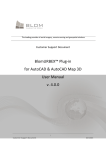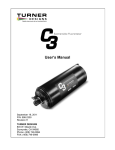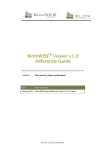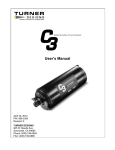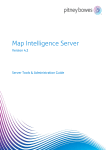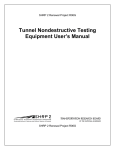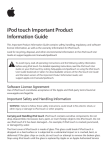Download ArcMap [v10.0- v.10.2] User manual
Transcript
The leading provider of aerial imagery, remote sensing and geospatial solutions Customer Support Document BlomURBEX™ ArcMap Plug-in User Manual v. 4.0.x i Customer Support Document Mar 2014 Revision History REVISION HISTORY Revision Date Reason 1.0 2.0 3.0 4.0 5.0 6.0 7.0 8.0 9.0 10.0 October 2010 November 2010 November 2011 November 2012 February 2013 May 2013 October 2013 January 2014 March 2014 March 2014 Document for release 2.5. Improvements in overlap. Release v2.5.2 Feature Improvements. Release v3.0 Development of Add In, Support for ArcMap 10.1 Bug Fixes – Release v3.5.1 Bug Fixes – Release v3.5.2 Document for release 4.0.0. Support for BlomSHOT Document for release 4.0.1 Document for release 4.0.19. Updater support. Document for release 4.0.21. ii Customer Support Document Mar 2014 Contents CONTENTS 1 Introduction ................................................................................................................... 1 2 System requirements ...................................................................................................... 2 3 Installing, uninstalling and updating BlomURBEX plug-in ................................................. 3 3.1 3.2 3.3 4 Install the plug-in ...........................................................................................................................3 Uninstall the plug-in .......................................................................................................................4 Update the plug-in .........................................................................................................................4 Starting with BlomURBEX ArcMap plug-in ....................................................................... 6 4.1 4.2 Setup the BlomURBEX Viewer plug-in in ArcMap...........................................................................6 Adding Data Sources ......................................................................................................................6 Adding BlomURBEXTM as a Data Source .................................................................................................................. 6 Adding BlomSHOTTM as a Data Source .................................................................................................................... 7 Adding Blom Library as a Data Source .................................................................................................................... 8 4.3 4.4 4.5 4.6 5 Manage the list of Datasources ...................................................................................................10 Setup the BlomURBEX Viewer basic options ................................................................................10 Changing language interface .......................................................................................................14 Changing layout ...........................................................................................................................14 Viewing BlomURBEX images ......................................................................................... 16 5.1 5.2 5.3 5.4 Selecting location in ArcMap ........................................................................................................16 Introducing known coordinates in BlomURBEX Viewer ................................................................16 Panning images ............................................................................................................................17 Magnifying images .......................................................................................................................17 Zooming with the zoom bar in one view............................................................................................................... 17 Zooming in or out with the mouse wheel in one view .......................................................................................... 18 Zooming to a extent in one view........................................................................................................................... 18 5.5 5.6 5.7 5.8 5.9 5.10 6 7 Changing views ............................................................................................................................18 The “intelligent” behavior ............................................................................................................19 Changing basemap ortho image ..................................................................................................20 Showing the visible and total extension in ArcMap .....................................................................21 Synchronizing views .....................................................................................................................22 Seeing historical images from different years ..............................................................................23 Obtaining image information ........................................................................................ 24 Using the measurement tools ....................................................................................... 26 7.1 7.2 7.3 7.4 7.5 Changing units of measure...........................................................................................................26 Viewing the coordinates of a location ..........................................................................................26 Measuring squared perimeter or distance ...................................................................................27 Measuring ground length .............................................................................................................28 Measuring bearing .......................................................................................................................28 iii Customer Support Document Mar 2014 Contents 7.6 7.7 7.8 7.9 7.10 7.11 8 Printing images............................................................................................................. 34 8.1 8.2 8.3 8.4 9 Measuring area ............................................................................................................................29 Measuring height .........................................................................................................................30 Measuring elevation ....................................................................................................................31 Measuring facade area ................................................................................................................31 Measuring diagonal length ..........................................................................................................32 Clearing measurements ...............................................................................................................33 Printing images ............................................................................................................................34 Changing print settings ................................................................................................................34 Page setup ....................................................................................................................................35 Print preview ................................................................................................................................35 Exporting images .......................................................................................................... 37 9.1 9.2 Exporting all visible views .............................................................................................................37 Projection of the extracted ortho images .....................................................................................37 10 Saving measurements ................................................................................................... 38 10.1 10.2 10.3 Setting measurement savings ......................................................................................................38 Starting and stopping save sessions .............................................................................................39 Procedure for saving measurements ............................................................................................40 11 Overlaying tile raster data............................................................................................. 41 11.1 Activating and deactivating tiled raster overlays .........................................................................41 12 Overlaying vector data.................................................................................................. 43 12.1 12.2 12.3 12.4 Activating and deactivating vector overlays ................................................................................43 Refreshing vector overlays ...........................................................................................................43 Overlay and performance considerations ....................................................................................44 Symbology limitations ..................................................................................................................44 13 Adding BlomURBEX to ArcMap as a WMS layer ............................................................. 45 14 Troubleshooting ........................................................................................................... 49 14.1 Log files ........................................................................................................................................49 15 Appendix A: how to add new projections ...................................................................... 50 16 Appendix B: how to improve interface translation ......................................................... 51 iv Customer Support Document Mar 2014 BlomURBEX™ ArcMap Plug-in 1 INTRODUCTION BlomURBEX™ is an online geographic information server (geoserver); it has been developed by Blom to allow on-line access to all of our data products. The BlomURBEX content includes a revolutionary collection of geographical datasets including high resolution aerial imagery, LiDAR and raster data. Functionality within BlomURBEX allows the user to navigate, measure, export and search. The BlomURBEX™ server has been specially designed to provide fast access to tiled geo-referenced data models. The data and functionality can be accessed through a variety of technologies and applications. Blom has a collection of standard API’s / SDK’s which allow users to create their own integrations with intranet solutions or web mapping products. Alternatively users can access BlomURBEX™ through pre-developed GIS plug-ins or via Blom’s new viewing application BlomWEB™. The many different methods of accessing BlomURBEX™ emphasises the flexibility of the service and how this geoserver can meet all customer requirements, however varied they may be. Currently there are over a thousand urban areas represented by aerial imagery and hundreds of 3D models. BlomURBEX™ is designed to serve all products and services provided by Blom, but data belonging to the client or a third party can also be tiled and uploaded to the server to be used by the client alongside the Blom data. Based on the same interface, Blom has developed a full range of plug-ins that integrates BlomURBEX services into GIS and CAD applications. Blom currently has the following Plug-ins available. BlomURBEX plug-in for ESRI ArcMap (ArcView, ArcEditor and ArcInfo) BlomURBEX plug-in for ESRI ArcIMS BlomURBEX plug-in for ESRI ArcGIS Server BlomURBEX plug-in for Intergraph GeoMedia Professional BlomURBEX plug-in for Integraph GeoMedia WebMap BlomURBEX plug-in for Autodesk Map and AutoCAD BlomURBEX plug-in for Autodesk MapGuide BlomURBEX plug-in for Bentley MicroStation BlomURBEX plug-in for MapInfo Professional BlomURBEX plug-in for MapInfo MapXtreme Software downloads can be found on our website on our dedicated software page 1 Customer Support Document Mar 2014 BlomURBEX™ ArcMap Plug-in 2 SYSTEM REQUIREMENTS Microsoft .NET Framework 2.0, 3.5 and 4.0 The BlomURBEX ArcMap plug-in has been developed with Microsoft .NET Framework 2.0, 3.5 and 4.0. These frameworks must be present prior to install. ESRI ArcGIS Desktop The BlomURBEX ArcMap plug-in supports all 10.x versions of ESRI ArcGIS Desktop products, including ArcView, ArcEditor and ArcInfo. It is a requirement to have any of these products from ESRI installed before installing the BlomURBEX ArcMap plug-in. Windows versions The BlomURBEX ArcMap plug-in 10.x supports the following operative systems: Windows 2008 Server Standard, Enterprise & Datacenter (32-bit and 64-bit) SP2 Windows 2008 R2 Server Standard, Enterprise & Datacenter (64-bit) Windows 7 Ultimate, Enterprise, Professional, Home Premium (32-bit and 64-bit) Credentials for BlomURBEX Web Services To access BlomURBEX Web Services a user/password credentials (and its matching usertoken) are needed. Contact with Blom Marketing Department to obtain them: http://www.blomasa.com/contact.html 2 Customer Support Document Mar 2014 BlomURBEX™ ArcMap Plug-in 3 3.1 INSTALLING, UNINSTALLING AND UPDATING BLOMURBEX PLUG-IN Install the plug-in The installation process with the BlomURBEX ArcMap Plug-in is now completed via an ESRI add-in. This has a lot of advantages and has simplified the installation process. In the folder supplied by Blom there will be two files. To install, double click in the add-in file. ArcGIS will automatically recognise this as an add-in file and will opens the “ESRI ArcGIS Add-In Installation Utility”. Select “Install Add-In”, the application is now installed! 3 Customer Support Document Mar 2014 BlomURBEX™ ArcMap Plug-in 3.2 Uninstall the plug-in If you wish to uninstall the ArcMap plug-in there are two simple methods. 1. Close any open ArcMap. 2. Browse to C:\Users\<User>\Documents\ArcGIS\AddIns where <User> = Your username 3. Within this folder locate the folder that contains the following file “Blom.Urbex.Plugins.ArcMap.10_x <version>.esriAddIn”, where <version> = version of the plugin. 4. Delete this folder. Or 1. Open ArcMap 2. Go to Customise > AddIn Manager 3. Select the plug-in in the list on the left then Select “Delete this Add-in” 3.3 Update the plug-in In the plug-in toolbar select the menu About > Check for updates. This launches de “Update plug-in” utility. If a new version of the plug-in is available, then it is reported. Click in the “What´s new in this version?” link to download and show the “What´s new” file with the information about changes. 4 Customer Support Document Mar 2014 BlomURBEX™ ArcMap Plug-in Also check the “Check for updates automatically” checkbox to check if newer versions exists in background. If a newer version is available, leave the Update plug-in window opened, close ArcMap and then click in “Install new version” to download the new version, uninstall previous version, and install the new one. Alternatively, click in “Continue without installing updates” to exit the utility. 5 Customer Support Document Mar 2014 BlomURBEX™ ArcMap Plug-in 4 4.1 STARTING WITH BLOMURBEX ARCMAP PLUG-IN Setup the BlomURBEX Viewer plug-in in ArcMap To execute the plug-in, follow these steps: 4. Open ArcMap. 5. If the Blom toolbar is not visible then select then select the menu Customize > Toolbars > BlomURBEX. 6. The BlomURBEX toolbar should appear. 7. Select the “Open BlomURBEX Viewer” icon. The BlomURBEX window, which is dockable, will open. Initially, the view inside the BlomURBEX window is empty until a data source is selected. It is possible to dock or release it, resize, and auto-hide this window. Changes made to the window will remain in your next sessions of ArcMap. 8. To close the window click in the close icon in the upper right corner of the window, this window can be reopened by selecting Customize > Toolbars > BlomURBEX again. 4.2 Adding Data Sources A Data Source is a repository of complex cartographic data. In order to work with a Data Source it must be selected. The Plug-in supports three different Data Sources: BlomURBEXTM online services. A central repository of all Blom data available trough online requests. BlomSHOTTM servers. A copy of some Blom data in a dedicated server in the customer facilities. Blom Libraries. A local copy of the Blom data for a city or a region workable as offline data. Adding BlomURBEXTM as a Data Source 1. In the BlomURBEX Viewer toolbar, click in the “Change Settings” button, to open the Settings dialog. 2. In the dialog select “BlomURBEX Datasources” tab. 3. In the tab select the sub-tab “BlomURBEX”. 6 Customer Support Document Mar 2014 BlomURBEX™ ArcMap Plug-in 4. In the “User” and “Password” textbox type the username/password provided by Blom. Contact with Blom Marketing Department to obtain them. The username/password is needed to connect to the BlomURBEX Web Services and allow the access to the imagery. 5. Click “Add Datasource” button and then “Save changes” button to finish configuration. Adding BlomSHOTTM as a Data Source 1. In the BlomURBEX Viewer toolbar, click in the “Change Settings” button, to open the Settings dialog. 2. In the dialog select “BlomURBEX Datasources” tab. 3. In the tab select the sub-tab “BlomSHOT”. 7 Customer Support Document Mar 2014 BlomURBEX™ ArcMap Plug-in 4. In the “User” and “Password” textbox type the username/password provided by Blom. In the “server” textbox type the name of the BlomSHOT server. Contact with Blom Marketing Department to obtain them. The username/password/server is needed to connect to the BlomSHOT Web Services and allow the access to the imagery. 5. Click “Add Datasource” button and then “Save changes” button to finish configuration. Adding Blom Library as a Data Source 1. In the BlomURBEX Viewer toolbar, click in the “Change Settings” button, to open the Settings dialog. 2. In the dialog select “BlomURBEX Datasources” tab. 3. In the tab select the sub-tab “Blom Local Library”. 8 Customer Support Document Mar 2014 BlomURBEX™ ArcMap Plug-in 4. Click in the “Manage licenses…” button to open the “License Manager” dialog. In it click in the “Add new license…” button and browse and select a valid license file. If the file is correct the dialog will show the expiration date and will tag it as “NEW license” or “OLD license”. But if it was invalid it will be tagged as “Corrupted” or “Invalid license”. Contact with Blom Marketing Department to obtain a valid license file. To remove a license file from License Manager select the license in the dialog an Click in the button “Remove”. License files are stored in a folder in the Windows user folder. Finally, click in “Close” button to dismiss the dialog. Click “Browse” button and select a valid Blom Library folder. The path will be shown in the “Library path” textbox. Alternatively, type the path in the textbox. 5. Click “Add Datasource” button and then “Save changes” button to finish configuration. 9 Customer Support Document Mar 2014 BlomURBEX™ ArcMap Plug-in 4.3 Manage the list of Datasources The rendering order of the Datasources in the viewer can be changed. To that follow these steps: 1. In the BlomURBEX Viewer toolbar, click in the “Change Settings” button, to open the Settings dialog. 2. In the dialog select “BlomURBEX Datasources” tab. 3. Select the Datasource to modify in the “Current loaded datasources” list. Click in the “Up” or “Down” buttons to move the datasource up or down in the list. Also clik in the “Remove” button to remove the selected datasource. The upper datasources are drawn on top of lower ones when they overlap. 4. Click in the “Save changes” button to re-start the viewer with the new configuration. The viewer will be re-center accordingly. 4.4 Setup the BlomURBEX Viewer basic options The first thing to do in an application that uses BlomURBEX Viewer is to specify some minimum options in order that the viewer can correctly search for images. For this follow the next steps. 1. In the BlomURBEX Viewer toolbar, click in the “Change Settings” button, to open the Settings dialog. 2. In the dialog select “Linking” tab. 10 Customer Support Document Mar 2014 BlomURBEX™ ArcMap Plug-in 3. Click in the “Select projection” button to open the “Select projection” dialog. In the dialog select in the available projection list the one that the basemap has. There are different options to select the desired projection: 4. To select a projection from the full list of supported projections, choose “Show all projections” in the upper dropdown box. To select click in the list and then click in OK, or double click an item in the list. Any item chosen will be reminded later in a list with the most used projections, so it is not needed to find it again in the long list. Also, it is possible to add any item to this “most used” list without leaving the dialog clicking with right mouse button and selecting “Add to most used” from the context menu. 11 Customer Support Document Mar 2014 BlomURBEX™ ArcMap Plug-in 5. To select a projection from the reduced list of the most used projections, choose “Show most used projections” from the upper dropdown box. The list will show only those projections selected at least once or any other marked explicitly as “most used”. To select click in the list and then click in OK, or double click an item in the list. Alternatively, it is possible to remove items from this “most used” list clicking with the right mouse button and selecting “Remove from most used”. The current selected projection cannot be removed from this list. 12 Customer Support Document Mar 2014 BlomURBEX™ ArcMap Plug-in 6. To select a projection from a reduced list using a filter, choose “Use a filter” in the upper dropdown box. The filter textbox and Filter button will activate. Type a search word or words in the filter textbox and press Filter. Only the projections containing the full search text will be shown. The search is possible by EPSG code and also by the projection name, and is case insensitive. To select click in the list and then click in OK, or double click an item in the list. The selected projection will be recorded in the “most used” list as usual. 13 Customer Support Document Mar 2014 BlomURBEX™ ArcMap Plug-in 7. Click in the “Save changes” button to finish the configuration. Settings do not persist, if the Plug-in is reinstalled. We need to set the settings again in case of reinstallation. 4.5 Changing language interface To change the language interface follow these steps: 1. In the BlomURBEX Viewer toolbar, click in the “Change Settings” button, to open the Settings dialog. 2. In the dialog select “Settings” tab. 3. Select the appropriate language from the “Languages” dropdown box. 4. Click in the “Save changes” button. 4.6 Changing layout BlomURBEX Viewer can show one or several orientations at the time using different layouts, and view images of different dates. It is possible to change from one layout to other from “Layout” button in the BlomURBEX Viewer toolbar. Click in the dropdown box to show the five options available and select one. Automatically the settings are saved for future sessions. 14 Customer Support Document Mar 2014 BlomURBEX™ ArcMap Plug-in 15 Customer Support Document Mar 2014 BlomURBEX™ ArcMap Plug-in 5 VIEWING BLOMURBEX IMAGES The BlomURBEX Viewer is the window that shows BlomURBEX images. To open an image is needed to select a location, either clicking in the basemap in ArcMap or introducing a known coordinates. 5.1 1. 2. 3. 4. 5. Selecting location in ArcMap Open ArcMap with a basemap. Open BlomURBEX Viewer if it is not, as explained previously. Ensure that settings are correct, as previously indicated. Resize and move application windows so they can be seen comfortably. Open any map data in ArcMap. The data can use any projection if it is in the EPSG list in the BlomURBEX Viewer options. It is only needed to know the projection and to indicate this projection in the BlomURBEX Viewer settings dialog. Remember when changing the projection in the ArcMap map to modify the options in BlomURBEX Viewer matching the active one. 6. Once everything is right set, select the “Centre BlomURBEX Viewer on a Point” icon and then select the required location within your ArcMap workspace. 7. After some seconds BlomURBEX Viewer will open the best Blom images for that location, in all the orientations selected in the BlomURBEX Viewer layout. The images are centered in the selected point and show a crosshair. If no image appears consider if your user permissions do not allow seeing images for that location. 5.2 Introducing known coordinates in BlomURBEX Viewer 1. In BlomURBEX Viewer right click in any view opened and select “Goto coordinates…” option in the contextual menu that will appear. A textbox will be shown. 16 Customer Support Document Mar 2014 BlomURBEX™ ArcMap Plug-in 2. Introduce a correct longitude or X and latitude or Y coordinates, separating both value with comma. The projection for these coordinates must be the same of the current projection for the map in ArcMap, the same projection that was saved in the Settings dialog. 3. Click OK. 4. After some seconds BlomURBEX Viewer will open the best BlomURBEX images for that location, in all the orientations selected in the BlomURBEX Viewer layout. The images are centered in the selected point and show a crosshair. If no image appears consider if your user permissions do not allow seeing images for that location. 5.3 Panning images “Panning” is the default behaviour of the display when no tool is selected. 1. In BlomURBEX Viewer unselect any tool in the toolbar. 2. Click and hold the left mouse button in the view to pan. 3. Drag the image up, down, left, or right within the view, and finally release mouse. 5.4 Magnifying images It is possible to zoom in for more detail or zoom out for more context information. Simply change the image’s magnification by using the zoom buttons inside the views. Zooming with the zoom bar in one view 1. Each view has a zoom bar with a “+” button on top and a “-” button on bottom. Click “+” button to increase the zoom level, or “-” to decrease the zoom level. There are 20 zoom levels available for the “continuous” or “Ortho” view mode (see below about view modes). There are 6 zoom levels available for the “photo by photo” or “Oblique” mode. The last two levels in “Oblique” mode are a resample of level 4. 2. Alternatively drag the level indicator up or down to increase or decrease any number of zoom levels. Every view in the layout has its own level indicator, so changes in this only affect the view that contains that level indicator. 17 Customer Support Document Mar 2014 BlomURBEX™ ArcMap Plug-in Zooming in or out with the mouse wheel in one view Move the mouse wheel frontwards or backwards to zoom in or out in just one view. Zooming to a extent in one view 1. Unselect any tool selected in the toolbar so the “Pan” default tool activates. 2. Press SHIFT key in keyboard. 3. Click with left mouse button in any view and hold pressed. Drag to draw a rectangle. A rectangle appears showing the extent selected. Release button at the ending corner. 4. Map centers and zoom to the best level zoom that contains the selected extent. This action only affects the view used. 5.5 Changing views Initially each view in the layout has set an orientation, but it is possible to modify this selecting orientations orientation selector. In fact, it is possible to have the same image several times. For example, it is possible to use the dual view to have two times the same ortho image opened. It can be useful to have a master – detail view to study two distant buildings at the same time that are in the same photo. Each time an orientation is changed in a view this setting is saved so it will be used until changed again. There are two types of view modes: “Ortho”, that shows the images in a continuous mode, and “Oblique”, that shows images one by one. In both modes it is possible to do “Pan” in the map endlessly. In the Oblique mode a new image is loaded in a seamless way when “panning” reaches the border of the current loaded image. 18 Customer Support Document Mar 2014 BlomURBEX™ ArcMap Plug-in Oblique imagery shown in a “continuous” or “Ortho” mode may suffer some distortion due to the irregularities of the terrain model that affects the ortho-rectification process. In flatter terrains the distortion is lesser. Tools are unselected when the view mode changes. Remember to select again the tool if using one when the mode is changed. There are five types of orientations: “Ortho” orientation, that shows the image as an ortho-photo; “North”, that shows the image looking from south to north; “South”, from north to south; “East”, from west to east; and “West”, from east to west. To change the orientation click in the “O”, “N”, “S”, “E” or “W” buttons in the upper left control to activate the “Ortho”, “North”, “South”, “East” and “West” orientations, respectively. The size of each view in the layout can be changed through the use of splitter bars between the views. Just move the mouse in the boundary of two views, and when the cursor changes, drag and drop the splitter to change the size of the views. Each time the size is changed this setting is saved in settings. 5.6 The “intelligent” behavior At closer zoom levels, oblique rectified images show big distortion on the buildings, while at furthest zoom levels they do not offer better information than the ortho images. Each view in the BlomURBEX Viewer is configured in an “intelligent” way so that any request that attempts to change the zoom level of the view will check if the view is displaying any orientation other than Ortho, and in this case decide what set of images should be displayed: ortho, oblique rectified or natural obliques. 19 Customer Support Document Mar 2014 BlomURBEX™ ArcMap Plug-in 5.7 Changing basemap ortho image By default the ortho image shown as basemap is one from several images available in BlomURBEX server. These images are visible are certain resolutions, and among them are theses images: “satellite”, with low resolution of the data. This source data is available in the furthest zoom levels (1 to 13), and contains Blue Marble and Landsat 7 imagery. “countryortho”, imagery covering a whole country (or a region). This source data is available in the medium zoom levels (13 to 19), and contains imagery from several providers and from Blom. As can be seen at certain zoom levels different sources coexist. It is possible to change what layers must be shown as baselayers. For that follow these steps: 1. Right click in any view and select “Edit baselayers…” option in the context menu. The “Configure baselayers” dialog opens. 2. For load different baselayers instead of the default baselayers, uncheck the “Use default baselayers” checkbox. This will enable the “Available baselayers” and “Selected baselayers” lists. 3. Select one or many layers in the “Available baselayers”. Depending on the user agreement with Blom the layers should vary. Click in the “Add” button (>) to move that layers to the “Selected baselayers” list. To remove layers select them in the “Selected baselayers” list and click in the “Remove” button (<). Only layers in “Selected” list will be drawn. 20 Customer Support Document Mar 2014 BlomURBEX™ ArcMap Plug-in 4. Selected baselayers will be rendered following the order in the “Selected baselayers” list. Top in the list will be drawn last ones. To reorder the items in the list, select a layer and click in the “Up” or “Down” buttons. 5. To filter only the layers belonging to a user, type the username in the “Filter baselayers by user” textbox, and only layers available to that user will be shown in the list of all available layers. 6. For each baselayer the BlomURBEX server can provide different dates. To filter a range of dates for the images in the baselayer, uncheck the “All available dates” checkbox and select two years in the “From year” and “To year” combo-boxes. Only images in the selected baselayers that where captured during the period will be shown. The snapshot above shows two different “baselayers” of the same date side by side in a Two view layout. The left is the default baselayer, and the right is the baselayer called “countryortho”. 5.8 Showing the visible and total extension in ArcMap It is possible to see the visible and total extent of the opened BlomURBEX images drawn in ArcMap. To do this follow these steps: 21 Customer Support Document Mar 2014 BlomURBEX™ ArcMap Plug-in 1. In the BlomURBEX Viewer toolbar, click in the “Change Settings” button, to open the Settings dialog. 2. In the dialog select “Linking” tab. 3. Check the “Show visible extent” or “Show image total extent” checkboxes to show in ArcMap the extent of the images in the opened map. They are drawn as two graphics in the anntation layer of the map. By default visible extents are drawn in the color with index 3 in the current color table and total extents in the color with index 1. 5.9 Synchronizing views It is possible to synchronize the several views in the BlomURBEX layout, and synchronize them with the map opened in ArcMap. Each time a view changes its location or the map in ArcMap changes its location, all the rest change accordingly. To do this follow these steps: To synchronize only several views with the ArcMap map: 1. Right click in each view to sync and select the “Synchronized” option from the context menu. Only the views that show the “Synchronized “ option checked will be sync. To synchronize all the views with the ArcMap map: 2. In the BlomURBEX Viewer toolbar, click in the “Change Settings” button, to open the Settings dialog. 22 Customer Support Document Mar 2014 BlomURBEX™ ArcMap Plug-in 3. In the dialog select “Linking” tab. 4. Check the “Synchronize all views” checkbox. The “Synchronized” option of the views is ignored and all the views in the layout will stay in sync between them and with the ArcMap map. 5.10 Seeing historical images from different years It is possible to show imagery for different years in each view, making easier for user to follow the changes occurred in a spot of the city. To do this, follow these steps: 1. Right click in a view and select the “Datefilter” option in the context menu. A textbox is shown. Type a valid date range, as two years separated by hyphen. Press Enter to save the filter. Now the view will show only images captured during the period. If no image was captured then the view will show nothing. 2. To reset the filter to the default, that is to show the last available image, repeat step 1 but left the textbox empty and press Enter. 23 Customer Support Document Mar 2014 BlomURBEX™ ArcMap Plug-in Above both views of Eiffel tower from 2008 and 2009 6 OBTAINING IMAGE INFORMATION To obtain the information about the current opened image, right click in any view and select the “Show Properties” option. A message box appears with the extent information, the date of capture and the orientation of the image. The coordinates are in the projection defined in the Settings dialog as follows: 1. In the BlomURBEX Viewer toolbar, click in the “Change Settings” button, to open the Settings dialog. 2. In the dialog select “Linking” tab. Select the desired projection in the “Save location measurements” groupbox. 24 Customer Support Document Mar 2014 BlomURBEX™ ArcMap Plug-in 3. Click “Save changes” and dismiss the Settings dialog. Now use the “Show Properties” option and the coordinates will be in the selected projection. 25 Customer Support Document Mar 2014 BlomURBEX™ ArcMap Plug-in 7 USING THE MEASUREMENT TOOLS BlomURBEX Viewer offers various tools for measuring features visible in images. For example, it is possible to measure the distance between two points, the elevation of the terrain, building heights, bearing, area, perimeter, the coordinates of a point, etc. Before using the measurement tools, be sure that the unit of measure is set as desired. 7.1 Changing units of measure To change units of measure: 1. In the BlomURBEX Viewer toolbar, click in the “Change Settings” button, to open the Settings dialog. 2. In the dialog select “Settings” tab. Select the desired units: Meters or Feet. 3. Click “Save changes” and dismiss the Settings dialog. 7.2 Viewing the coordinates of a location Use the Location Tool to determine the location (the coordinates) of an object in an image both in ortho or oblique views. To determine the location of an object: 1. In BlomURBEX Viewer click the Location Tool. 2. Click the desired location on the image. 3. The point’s coordinates appear drawn in the view. If the projection selected in the Settings dialog is not Spherical Mercator, the same coordinates will be seen in both coordinate systems, Spherical Mercator and the selected one, in the desired units, meters or feet. 26 Customer Support Document Mar 2014 BlomURBEX™ ArcMap Plug-in For Oblique images, remember to click near the base of buildings for more accurate coordinates. 7.3 Measuring squared perimeter or distance Use the Distance Tool to measure perimeter—the distance around the outside edge of an object or distances both in ortho or oblique views. To measure perimeter by using a parallelogram or measure distances: 1. Click the Distance Tool. 2. Starting with one corner of the object, click with the left mouse button. 3. Click again for each new vertex. The outline of a polyline appears as new vertexes are added. In oblique mode take in mind that a workaround to the server must be done in each vertex and the measure takes longer. 4. When the polyline surrounds the shape being measured or distance being measured, double click with left mouse button. 5. The partial measurements and total length appears drawn in the view. 27 Customer Support Document Mar 2014 BlomURBEX™ ArcMap Plug-in 7.4 Measuring ground length Use the Ground Length Tool to measure a distance taking account of the relief of the terrain. To measure a ground length: 1. Click the Ground length Tool. 2. Starting with one point in the view, click with the left mouse button. 3. Click again for each new vertex. The outline of a polyline appears as new vertexes are added. In oblique mode take in mind that a workaround to the server must be done in each vertex and the measure takes longer. 4. When the polyline surrounds the distance being measured, double click with left mouse button. 5. The partial measurements and total length appears drawn in the view. The distance is calculated using heights available in BlomURBEX server. 7.5 Measuring bearing To measure bearing: 1. Click the Bearing Tool. 2. Click with the left mouse button on the starting point. 3. Click with the left mouse button on the ending point in the direction you want to measure the bearing of. The measurement appears drawn in view. Use the mouse to draw one line to measure bearing both in ortho or oblique views. Where start drawing the line is important, as shown in the following illustrations: 28 Customer Support Document Mar 2014 BlomURBEX™ ArcMap Plug-in 7.6 Measuring area The Area Tool lets to measure the area of any linear shape both in ortho or oblique views. After the perimeter of the area to be measured is outlined, the area measurement appears in view. To measure the area of any straight-sided shape: 1. Click the Area Tool. 2. Click in the display at the desired starting point. 3. Click again for every new vertex of the area. A polygon that returns to initial point is drawn automatically. 4. When outlined the entire perimeter, double click in the last vertex. 29 Customer Support Document Mar 2014 BlomURBEX™ ArcMap Plug-in 7.7 Measuring height Use the Height Tool to measure the height of an object in an Oblique image. (Because orthogonal images are captured straight down, the Height Tool doesn’t apply to the “continuous” or “Ortho” view mode.) To measure height: 1. Click the Height Tool. 2. Click with the left mouse button on a point at the base (where it meets the ground) of the object we want to measure the height of. Important: Be sure to measure height by starting at ground level and moving upwards. If the ground level starting point is not seen, then estimate its location. 3. Move the mouse upwards and click a new vertex at the ending point. 30 Customer Support Document Mar 2014 BlomURBEX™ ArcMap Plug-in Finish measuring here. Start measuring here. 4. The measurement appears drawn in view. 7.8 Measuring elevation Use the Elevation Tool to measure the elevation (height above sea level) of a point in an image. To measure the elevation: 1. Click the Elevation Tool. 2. Click the point whose elevation to measure. 3. The measurement appears drawn in view. 7.9 Measuring facade area Use the Facade Area Tool to measure the area of a facade. To measure the area: 1. Click the Facade Area Tool. 2. Click in each vertex of the facade with a left click and double left click in the last vertex. 3. The measurement appears drawn in view. 31 Customer Support Document Mar 2014 BlomURBEX™ ArcMap Plug-in 7.10 Measuring diagonal length Use the Diagonal Length Tool to measure the diagonal of a facade. This tool is very useful for fireman analysis of needed stairs to access buildings. To measure the diagonal: 1. Click the Diagonal Length Tool. 2. Using always left mouse button, click in the first vertex in base of the building, then click on the second vertex in the base, an then click on the top of the building. When selecting the top of the building the tool will constrain the direction in the vertical. 3. The measurement appears drawn in view. 32 Customer Support Document Mar 2014 BlomURBEX™ ArcMap Plug-in 7.11 Clearing measurements Use the Eraser Tool to clear measurements in the map display. To clear measurements: 1. Click the Eraser Tool. 2. The measurements are removed in all available views. 33 Customer Support Document Mar 2014 BlomURBEX™ ArcMap Plug-in 8 PRINTING IMAGES BlomURBEX Viewer let print all the views opened to the selected printer, setup the page options and preview the printing, along with the image properties if they were activated in the settings dialog. Before printing, scroll or pan the image so that the portion we wish to print is visible in the display. Also resize the views with the splitters and the size of the BlomURBEX Viewer window. The visible portion of each image, and with the exact pixel size, will be send to printer. 8.1 Printing images 1. To send all the current views to the printer with the current settings click the File > Print All Views…. Each view in the layout is printed in different page with the image information activated in settings. 2. To send only one view to the printer with the current settings right click in a view an select “Print image…” option in the context menu. Only the view clicked is printed. If the image information is longer than the page space, it will be cropped. In this case, try reducing the size of the BlomURBEX Viewer or the view, or limit the amount of information to print in settings dialog, as explained below. 8.2 Changing print settings To change the printing settings: 1. In the BlomURBEX Viewer toolbar, click in the “Change Settings” button, to open the Settings dialog. 2. In the dialog select “Settings” tab. In the “Printing settings” groupbox check or uncheck the options wanted. 34 Customer Support Document Mar 2014 BlomURBEX™ ArcMap Plug-in 3. Click “Save changes” and dismiss the Settings dialog. 8.3 Page setup To change page settings: 1. Click the File > Page setup menu. 2. The Page setup dialog opens. Modify the page margin, orientation, etc. as desired. Click OK to accept changes. 8.4 Print preview To preview the print: 1. Click the File > “Print all views preview” menu. 35 Customer Support Document Mar 2014 BlomURBEX™ ArcMap Plug-in 2. The Print preview dialog opens. Click in the options to see the print at different zooms o layouts. Also it is possible to print clicking in the Print button. The dialog can be resized to full screen. The image shows the preview of a dual view layout. Each view and its properties are print in different pages. 36 Customer Support Document Mar 2014 BlomURBEX™ ArcMap Plug-in 9 9.1 EXPORTING IMAGES Exporting all visible views The BlomURBEX Viewer “Export all views to image” menu lets exporting the visible extent of the active views to a set of JPG files. To export all current views to images: 1. Pan in the views to display the extent desired. 2. Click the “File > Export all views to image…” menu. 3. In the Save as dialog that opens introduce the path and filename for the file. The extracted image or images are saved with the filename specified. If the BlomURBEX layout shows several views, then several files will be created and all the files will be suffixed with a view number and orientation. Also, if a view is in ortho mode, a world file (JGW) is saved for easy integration of the image in other GIS packages. To export one view to an image: 1. Pan in any view to display the extent desired. 2. Right click the “File > Export image…” option in the context menu. 3. In the Save as dialog that opens introduce the path and filename for the file. 4. The extracted image is saved with the filename specified, and if it is an ortho image, a world file (JGW) is also saved. 9.2 Projection of the extracted ortho images The projection of the extracted ortho images are “Spherical Mercator”, the projection labelled by EPSG as 'Popular Visualisation CRS / Mercator' in March 2008 with code number 3785. 37 Customer Support Document Mar 2014 BlomURBEX™ ArcMap Plug-in 10 SAVING MEASUREMENTS BlomURBEX Viewer is able to notify when the user has made measurements in order to store this measures into any opened table in ArcMap. 10.1 Setting measurement savings To activate the measurement storage, it is needed to complete two one-time setup tasks. It is needed to specify some options about the place where store the measurements, and some options about the units and the projection to use (in the case the measurements are locations). To specify the options regarding the place to store measurements: 1. In the BlomURBEX Viewer toolbar, click in the “Change Settings” button, to open the Settings dialog. 2. In the dialog select “Linking” tab. In the “Options for saving measurements” groupbox select the options wanted. The groupbox has drop down menu choices for each column. Select the correct choice for your specific table requirements in the table you are creating. 3. If the list of tables shown do not match the current list of available layers in the ArcMap data frame you need to complete a “Sync” by closing the Settings dialog box and selecting a new point on the ArcMap workspace to refresh the BlomURBEX Viewer. When this command is executed, the Saving options are updated in the Settings dialog for the current drawing opened. 4. As seen in the screenshot, it is possible to select a sub-option from the dropdown lists for each type of measurement to save. It is possible to store seven different type of measurement. The 38 Customer Support Document Mar 2014 BlomURBEX™ ArcMap Plug-in table summarizes the relation between the BlomURBEX Viewer tools and the Column dropdown used to make the savings. In BlomURBEX Viewer the tool used is ... In ArcMap measurements are saved in the field selected in dropdown... Column for areas Column for distances Column for heights Column for elevations Column for X coords and Y coords Column for bearings 5. To store only some measurements, select <None> for those measurements in the dropdown lists. To specify the options regarding the units and the projection to use in locations: 1. In the “Settings” tab of “Settings” dialog, in the “Measurement options” panel, select the desired units, meters or feet. The values will be stored in the units selected. 2. In the “Linking” tab, in the “Save location measurements” panel, choose “in Spherical Mercator projection” for storing location data in Spherical Mercator meters, choose “in WGS84 Lat/Lon” for storing location data as longitude / latitude in the WGS84 spheroid, or more usual, use “in selected map projection of GIS” for storing location data in the projection of the current map in ArcMap. This last projection can be selected in the selector that is above the panel in the same “Linking” tab. This setting only affects the Location tool. 3. Click “Save changes” to save settings. 10.2 Starting and stopping save sessions In BlomURBEX Viewer it is possible to start, pause and continue the savings through an option. To start a save session: 1. Click in the “File > Start saving measurements” menu if it is unchecked. The menu will toggle to a checked state and measurements will be stored (if fields were correctly set). 39 Customer Support Document Mar 2014 BlomURBEX™ ArcMap Plug-in To pause a session: 2. Click in the “File > Stop saving measurements” menu if it is checked. The menu will toggle to an unchecked state and measurements will be paused. 10.3 Procedure for saving measurements The procedure for saving measurements is this: 1. Ensure that the “Start saving measurements” menu is checked so the text in the menu is now “Stop saving measurements”. 2. In ArcMap the layer with the table where measurements must be saved has to be in “Start editing” mode. Select one or several features in the layer. 3. Now in BlomURBEX Viewer do a measurement as described in this manual. 4. The measurement is saved in the table and the column specified in settings for selected features. 40 Customer Support Document Mar 2014 BlomURBEX™ ArcMap Plug-in 11 OVERLAYING TILE RASTER DATA BlomURBEX Viewer is able to overlay tile raster data from BlomURBEX server, both in “Ortho” and “Oblique” modes. In next chapter is explained how is possible to overlap also local vector data loaded in ArcMap. Both tile raster layers and local vector layers can be overlapped at the same time over the BlomURBEX Viewer. They all are treated as layers and drawn on top of the basemap imagery. 11.1 Activating and deactivating tiled raster overlays To activate or deactivate the raster overlays follow these steps: 1. Right click in any view and select the option “Edit tiled overlay layers…” from the context menu. The “Configure tiled overlay layers” opens. 2. The “Available tiled overlay layers” list shows the names the available overlay layers in the server. Select one or several from the list and press the “Add” button to add them to the “Selected tiled overlay layers” list. Only layers in thislist, and in the order shown, will be rendered in the view on top the base layer. 41 Customer Support Document Mar 2014 BlomURBEX™ ArcMap Plug-in 3. To change the drawing order select one layer in the “Selected tiled overlay layers” list and press in the “Up” or “Down” buttons. 4. Select the “Follow user orientation” radio button to overlay in any orientation of the view. Select “Select orientation” radio button to filter which orientation will have overlays. In this case press in any orientation button and it will be marked in orange. 5. For overlay layers the BlomURBEX server can provide different dates. To filter a range of dates for the images in the overlay layers, uncheck the “All available dates” checkbox and select two years in the “From year” and “To year” combo-boxes. Only images in the selected overlay layers that where captured during the period will be shown. 6. Click OK to proceed and save changes. Tile raster overlay with TomTom street map 42 Customer Support Document Mar 2014 BlomURBEX™ ArcMap Plug-in 12 OVERLAYING VECTOR DATA BlomURBEX Viewer also has the ability to overlay vector data from ArcMap on top of the BlomOBLIQUE and BlomORTHO imagery. 12.1 Activating and deactivating vector overlays To activate or deactivate the vector overlays click in “Overlay vector layers” button in the BlomURBEX toolbar . This setting is not saved for better performance initialization. BlomURBEX Viewer always start with the setting uncheck. It is needed to set it explicitly in each BlomURBEX Viewer session. 12.2 Refreshing vector overlays When Overlay option is activated all the existing layers in the ArcMap map display are added to BlomURBEX views. If a new layer is added or any feature is modified in its geometry after activating the Overlay option, these changes are not shown immediately. To reflect these changes is needed to click in the “Reload overlays” button in the BlomURBEX Viewer toolbar . This function again adds the layers to BlomURBEX; cleans all the overlays and redraw again the vector data. 43 Customer Support Document Mar 2014 BlomURBEX™ ArcMap Plug-in Due to their size and nature Vector layers can sometimes take a while to load. If you want a faster refresh rate it is best to reduce the size of the vector data file. If you find large accuracy issues please check your ArcMap workspace projection and the BlomURBEX Viewer projection – they must match. Remember vector data will always have a small shift when viewed in the BlomOBLIQUE view due to the angle of the image. For a higher accuracy view in the vertical view. 12.3 Overlay and performance considerations To overlap geometries faster, a combination of requests to BlomURBEX server and local interpolations is done. It is possible to adjust the precision of the interpolations. For that, follow these steps. 1. Open Settings dialog. 2. Select the Overlays tab. 3. The amount of points used for the interpolation determines the accuracy. It is possible to use no less than four points and no more than 400 points. Change this clicking up or down the “Points of interpolation” textbox. More points interpolate more accurately but are slower. Default is 100. 12.4 Symbology limitations The BlomURBEX Viewer has less symbology properties than ESRI; the following statements are limitations of the current version: Only ArcMap layers with a simple rendering can be viewed in the BlomURBEX viewer. Thematic layers cannot be viewed. Points will be shown as circles, but the size, background and outline are correctly represented. The BlomURBEX Viewer support the “Simple marker Symbol”, “Character marker symbol” and “Picture marker symbol”, any other points used will not be viewable. Polylines support the “Simple Line Symbol” and some properties of the “Cartographic line Symbol”, both single and multi-layered. Polyline layers that use other styles will not be viewable. Polygons support the “Simple Fill Symbol” and some properties of the “Line Fill Symbol”, both single and multilayered. Polygon layers that use other styles will not be viewable. 44 Customer Support Document Mar 2014 BlomURBEX™ ArcMap Plug-in 13 ADDING BLOMURBEX TO ARCMAP AS A WMS LAYER The vertical imagery hosted on the BlomURBEX geoserver “BlomORTHO” can be added into ArcMap as a WMS layer. 1. Open a new or existing Arc workspace. 2. Open the catalog window. 3. Select “GIS Servers”, double left click “Add WMS Server”. 4. This opens an Add WMS Server dialog box, in the URL: section type the following http://www.blomurbex.com/v02/GetMap?usertoken=usertoken& where usertoken = Your BlomURBEX usertoken. 5. Next select the “Version” from the drop down menu, select 1.3.0. 6. Then select “Get Layers”. 45 Customer Support Document Mar 2014 BlomURBEX™ ArcMap Plug-in 7. A list of layers will appear, select any layer that appears under the “Maps WGS84” section, for example “Ortho Images WGS84”, select “OK”. 8. In the catalog window in the ArcMap workspace a new entry called “Blom on www.blomurbex.com” will appear it the GIS servers section. 9. Browse to the “Ortho Images WGS84” option. 46 Customer Support Document Mar 2014 BlomURBEX™ ArcMap Plug-in 10. If the ArcMap work space is not is the WGS84 projection then a warning message regarding conflicting projections will appear. This warning can be accepted. 11. The BlomURBEX ortho imagery will then appear directly within the Arc workspace. 12. When viewing the oblique mosaics in any other direction that North the image appears “upside down”, this is due to the ArcMap work space having a north direction. 47 Customer Support Document Mar 2014 BlomURBEX™ ArcMap Plug-in 13. To rectify this problem open the ArcMap Data Frame tool. 14. Change the rotation of the data frame, for example the South imagery should be viewed with an angle of 180 degrees. 48 Customer Support Document Mar 2014 BlomURBEX™ ArcMap Plug-in 14 TROUBLESHOOTING 14.1 Log files If the applications do not work as expected, the best way to know what is happening is to activate the logging utility. Troubleshooting any issues is easier if log files are created and supplied to the Blom technical support team. In BlomURBEX Viewer, to activate logs, open the Settings dialog, and in the General tab, select the desired level for logs. To deactivate logs just select None as log level. To activate logs select Error, Warning, or Information level (in order from minimum to maximum verbose). To open the log file click in “Open log” button. 49 Customer Support Document Mar 2014 BlomURBEX™ ArcMap Plug-in 15 APPENDIX A: HOW TO ADD NEW PROJECTIONS The projection support relies on the PROJ4 public domain library. An “epsg” file is provided in the installation folder of the BlomURBEX Viewer. This file contains the EPSG codes, names and parameters for the coded projections. The epsg file is installed by ArcGIS in this folder: C:\Users\<user name>\AppData\Local\ESRI\Desktop<version>\AssemblyCache\<GUID>\ <user name> = name of the user <version> = ArcMap version (10.0 or 10.1) <GUID> = identifier If the <GUID> folder is not visible, you must activate the visibility of system files in the Windows folder options. There are several <GUID> folders; each one is for a different plug-in. Browse to the one that contains the epsg file. If you need to modify an existing projection, or to add support for new projections, modify this file with any text editor following the PROJ4 rules for parameters. See the http://proj.maptools.org/ webpage for more information. For example, if support for the Microsoft Live Maps projection is needed, add the next two lines to the file (the second line looks longer but is only one): # World Mercator <54004> +proj=merc +lat_ts=0 +lon_0=0 +datum=WGS84 +units=m no_defs <> +k=1.000000 +x_0=0 +y_0=0 +ellps=WGS84 Or support for Google Maps projection: #Google <900913> +proj=merc +a=6378137 +b=6378137 +lat_ts=0.0 +lon_0=0.0 +x_0=0.0 +y_0=0 +k=1.0 +units=m +nadgrids=@null +wktext +no_defs <> To optimize the Select projection dialog, delete from the “epsg” file any projection that not needed. Remember that each projection in the file uses two lines, do not break the format of this file or BlomURBEX Viewer could not work correctly. Once the “epsg” file is modified, open again the Settings dialog in BlomURBEX Viewer and reselect again the projection to refresh internal BlomURBEX settings. 50 Customer Support Document Mar 2014 BlomURBEX™ ArcMap Plug-in 16 APPENDIX B: HOW TO IMPROVE INTERFACE TRANSLATION The BlomURBEX Viewer interface supports twelve languages. The strings for each language are stored in the registry, HKEY_CURRENT_USER / SOFTWARE / Blom / Urbex 2.0. Each language has a section: english (en), español (es), deutsch (de), français (fr), italiano (it), nederlands (nl), portugués (pt), dansk (da), norsk (no), svenska (sv), suomi (fi), româna (ro). Each string uses a pair name-value. The name is an easy-to-understand name. For example, “AboutBoxForm.Description” is the description for BlomURBEX Viewer that appears in the About dialog. Change these values at your convenience using the registry editor. Next time you open BlomURBEX Viewer will reflect your changes. If any value is missing, the default value used is the English string. To return to original translation values, just delete de registry folder (da, de, en, etc) of the language entries you want to reset. Next time that language is selected inside the plugin, the original entries will be restored in registry for that language. 51 Customer Support Document Mar 2014
























































![Intergraph Geomedia [6.1-2013] User manual](http://vs1.manualzilla.com/store/data/005689587_1-58c82d14f3ba8ebe92b5c45af00d079c-150x150.png)
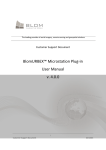
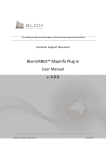
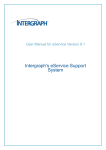
![MapInfo [v9.5 - v10.0] User manual PDF](http://vs1.manualzilla.com/store/data/005662542_1-c58f11f989f54f88b5c049879cd1b1b4-150x150.png)
![Autocad [2007-2009] User manual](http://vs1.manualzilla.com/store/data/005776291_1-e398978f20775312922048f8d5b8f7a5-150x150.png)
![Autodesk MAP [2007-2009] User manual](http://vs1.manualzilla.com/store/data/005814944_1-7d4ade0f748ad8f526e057550ef902e1-150x150.png)
